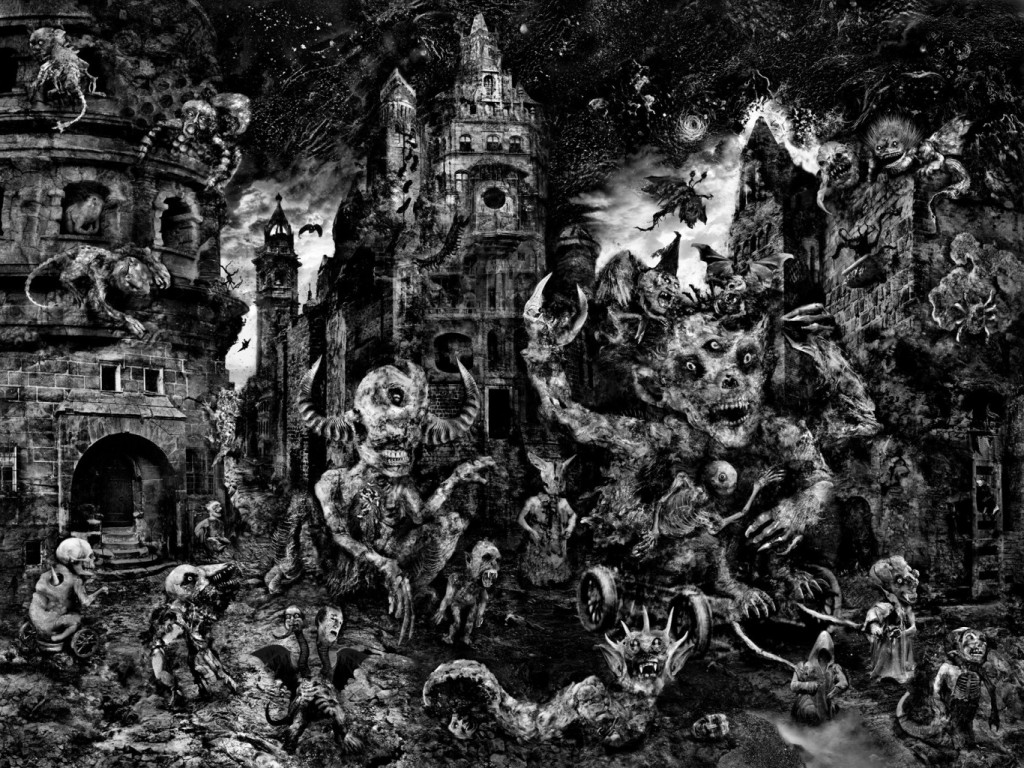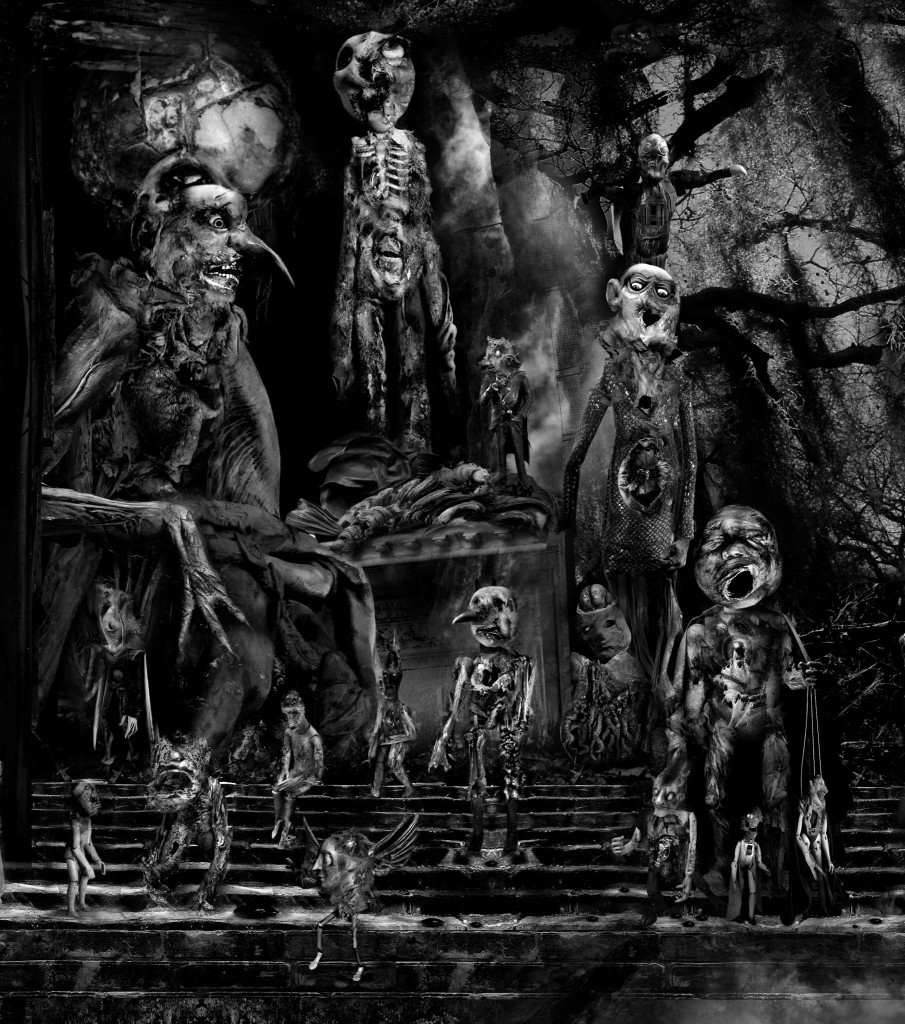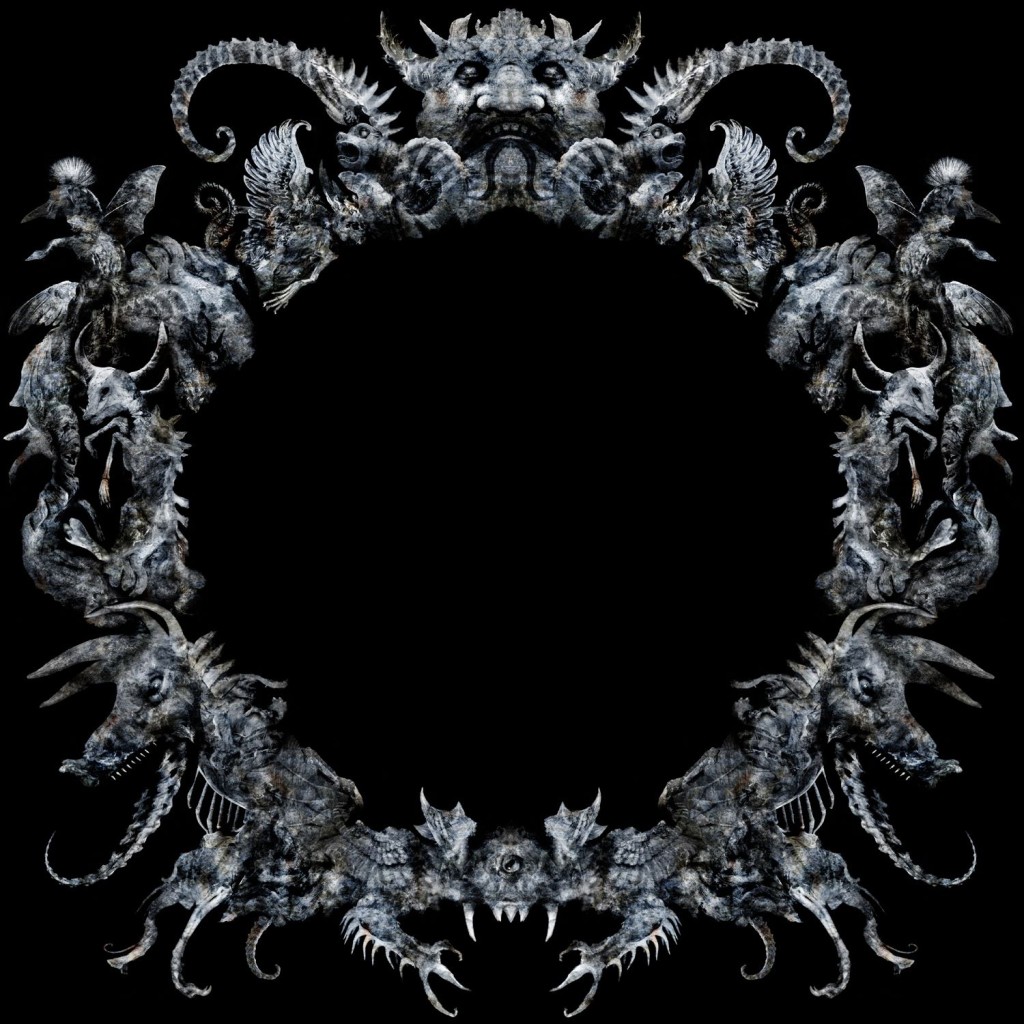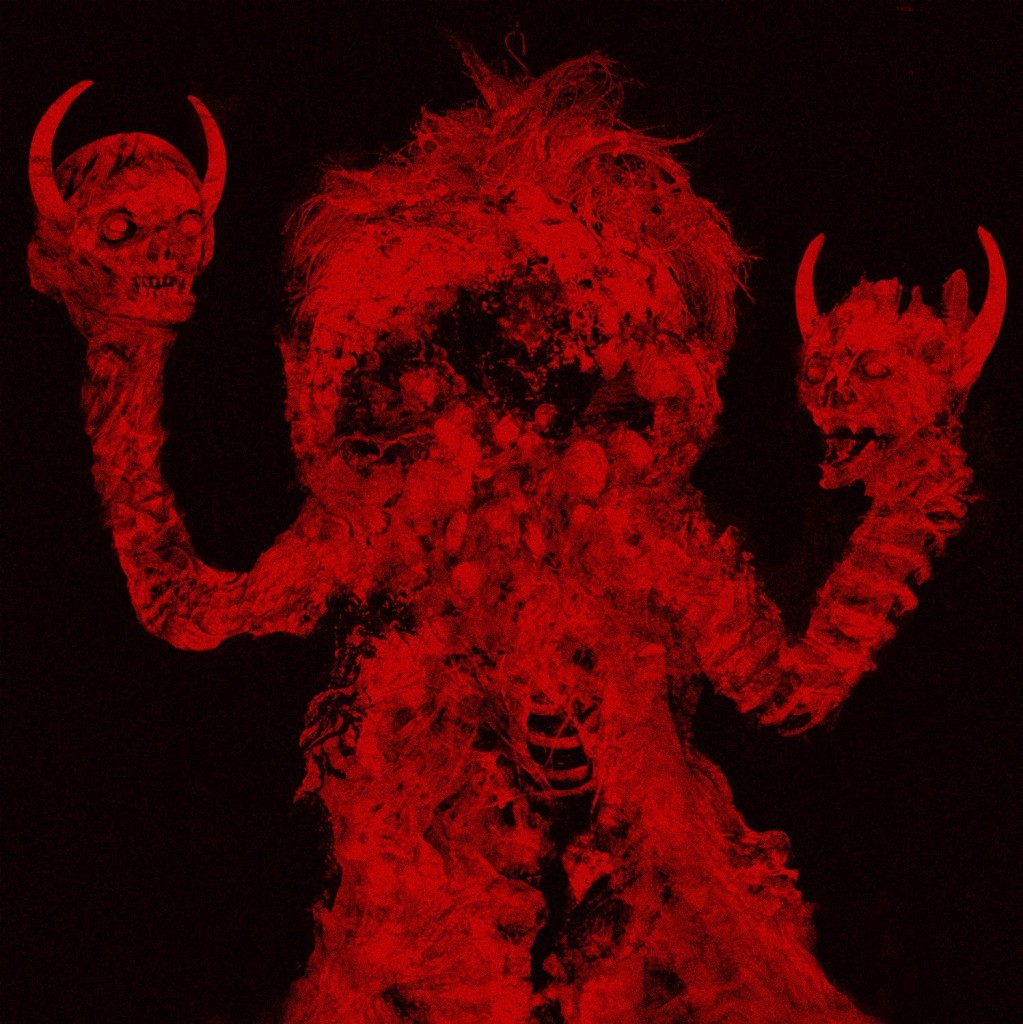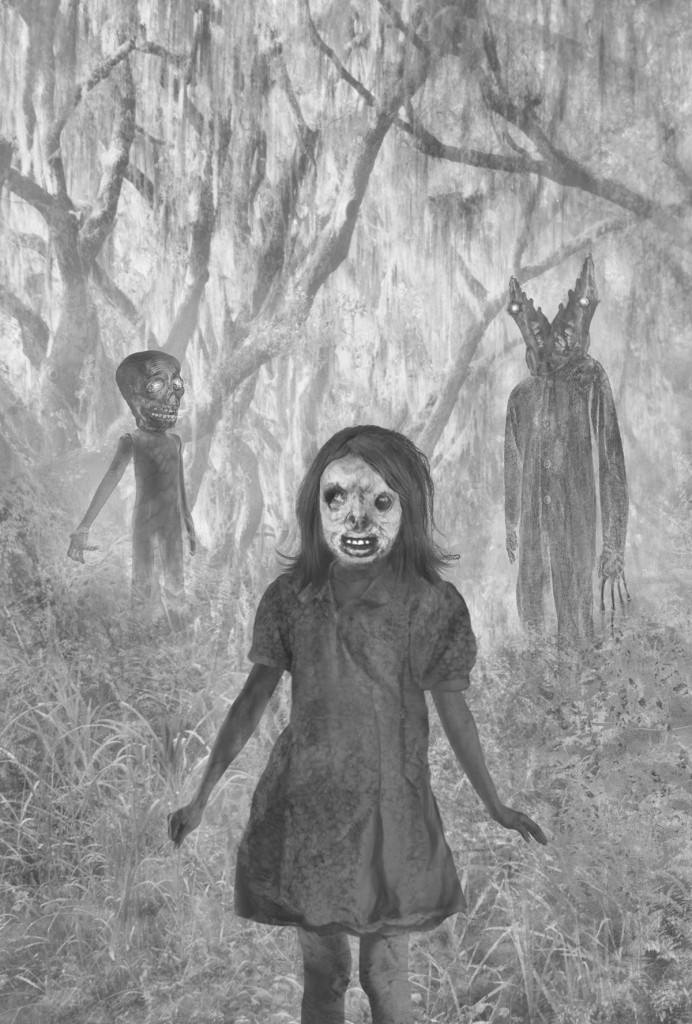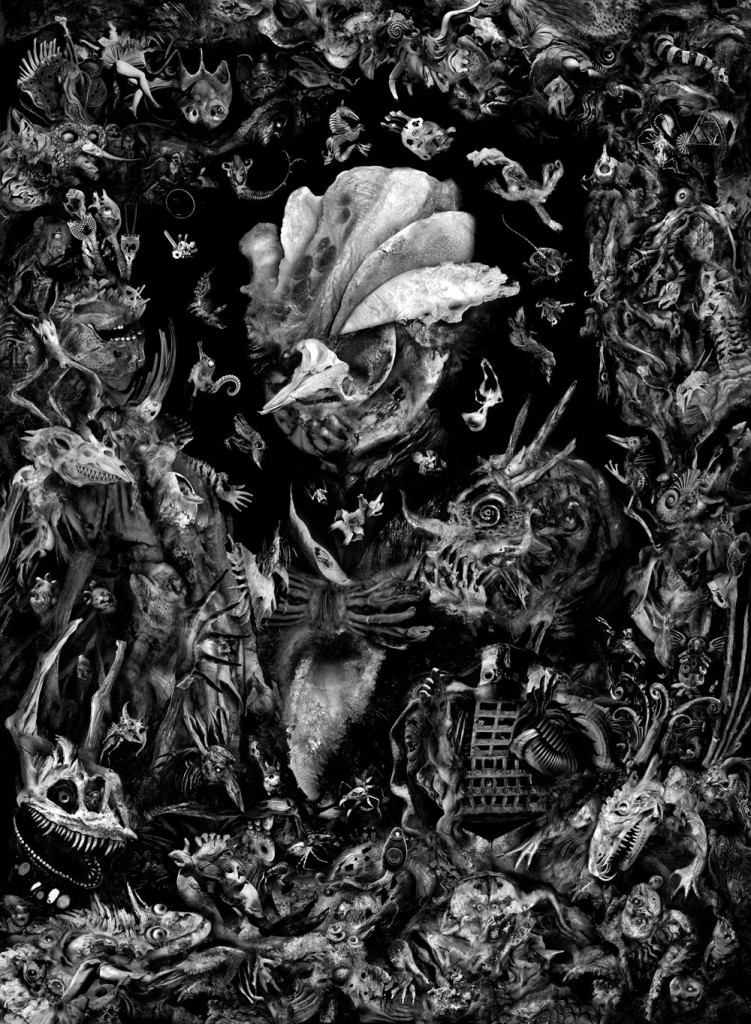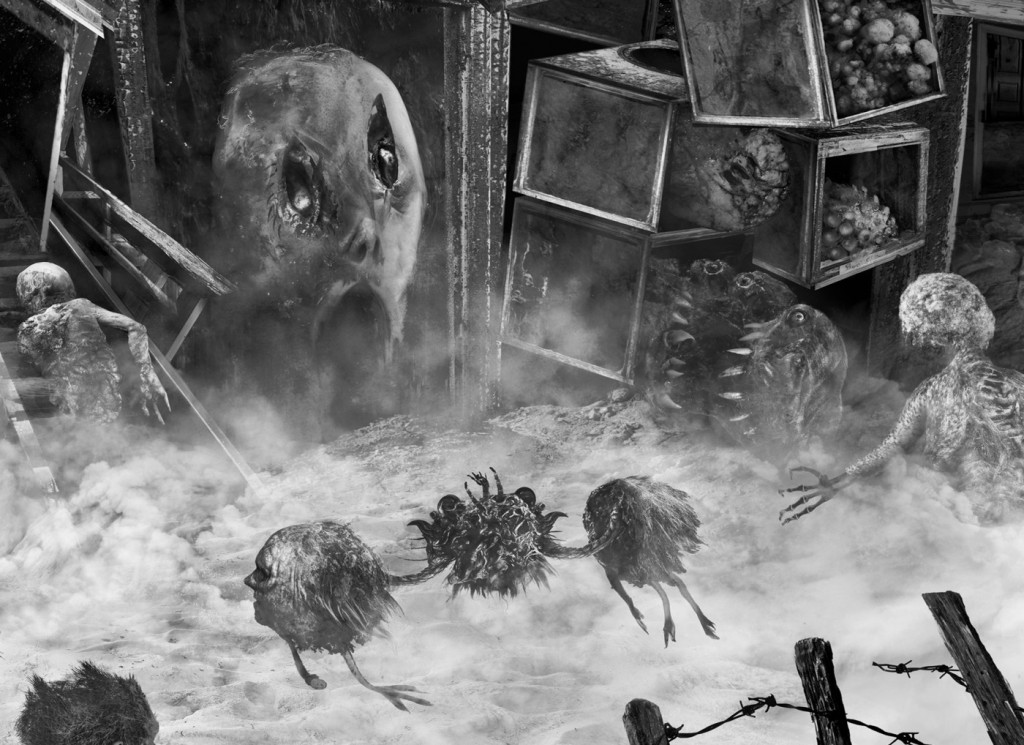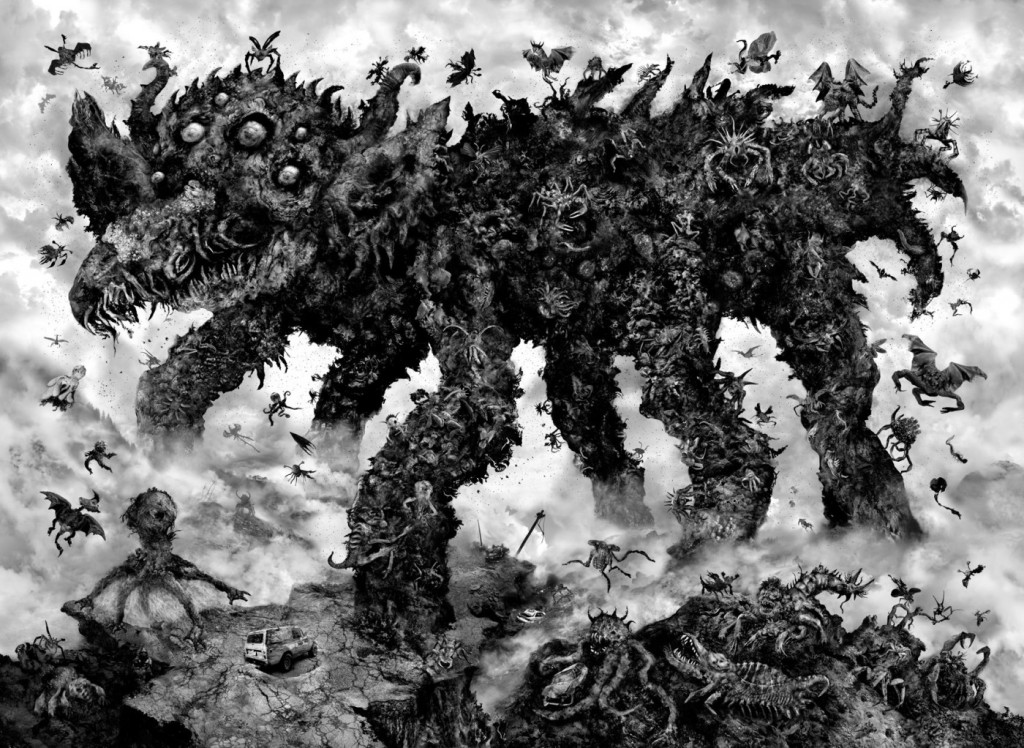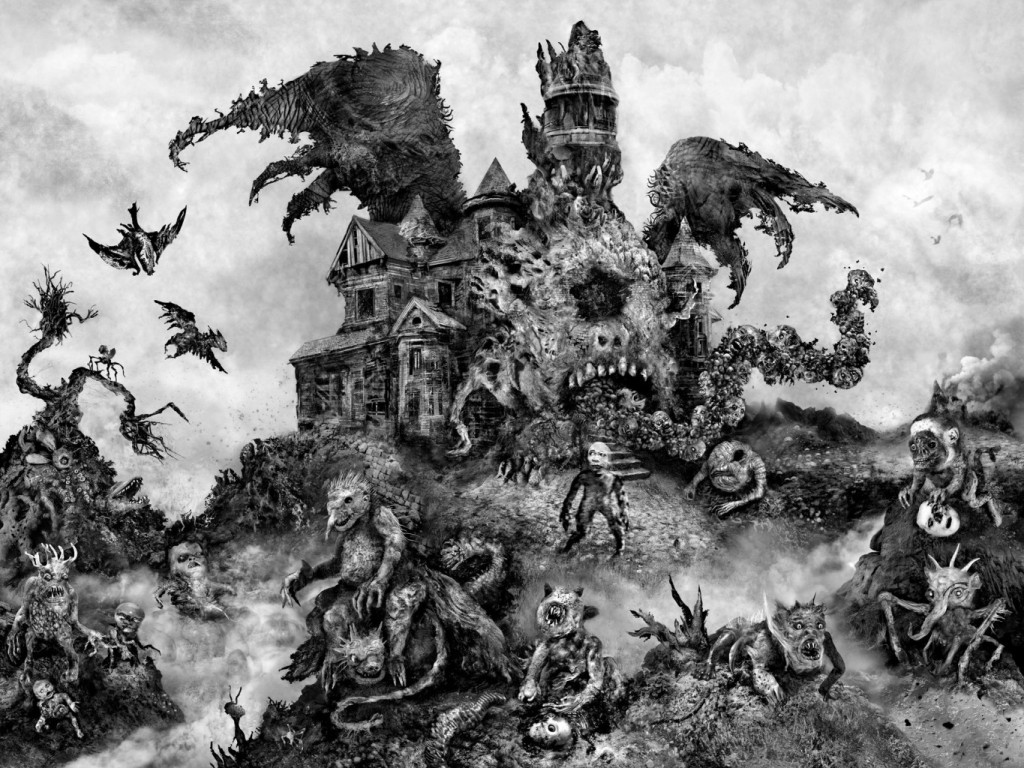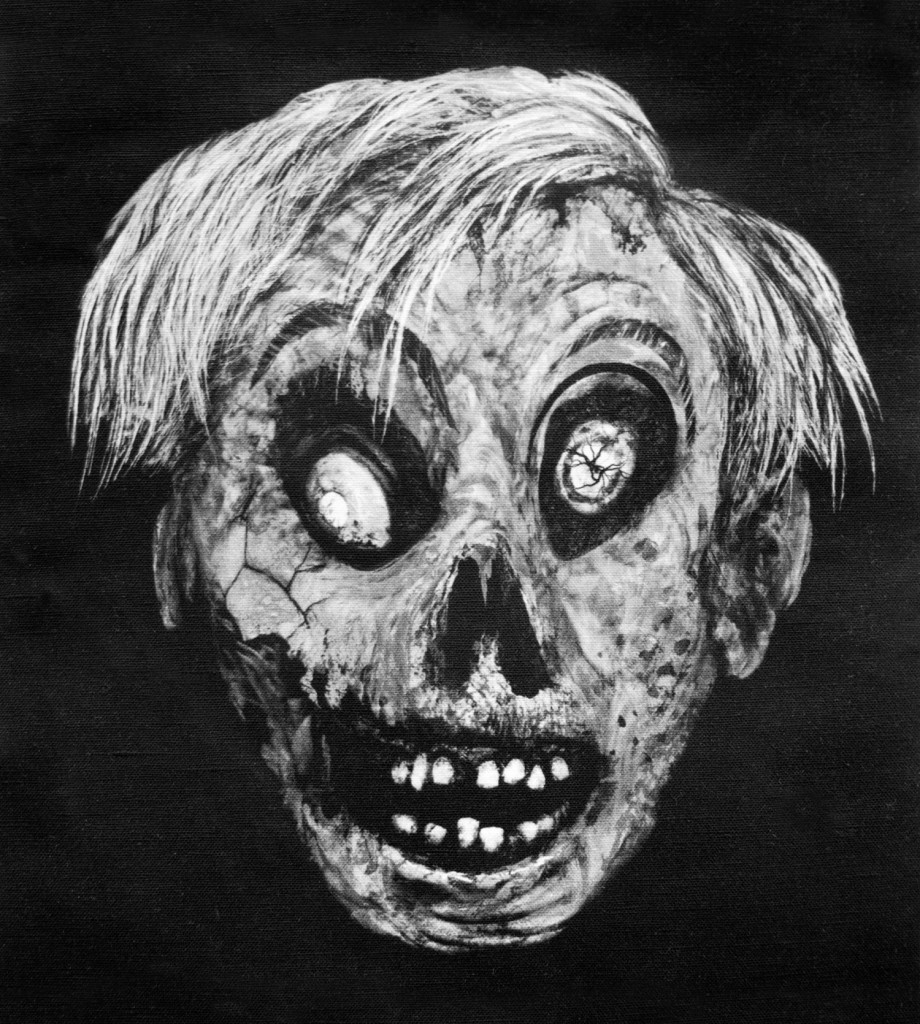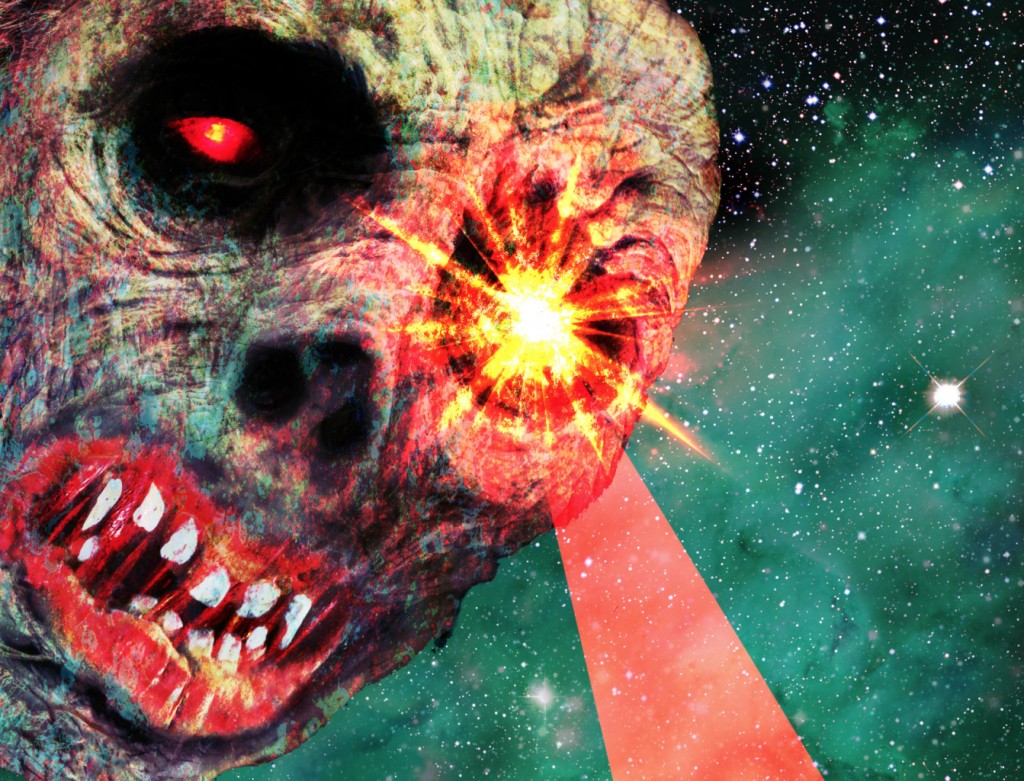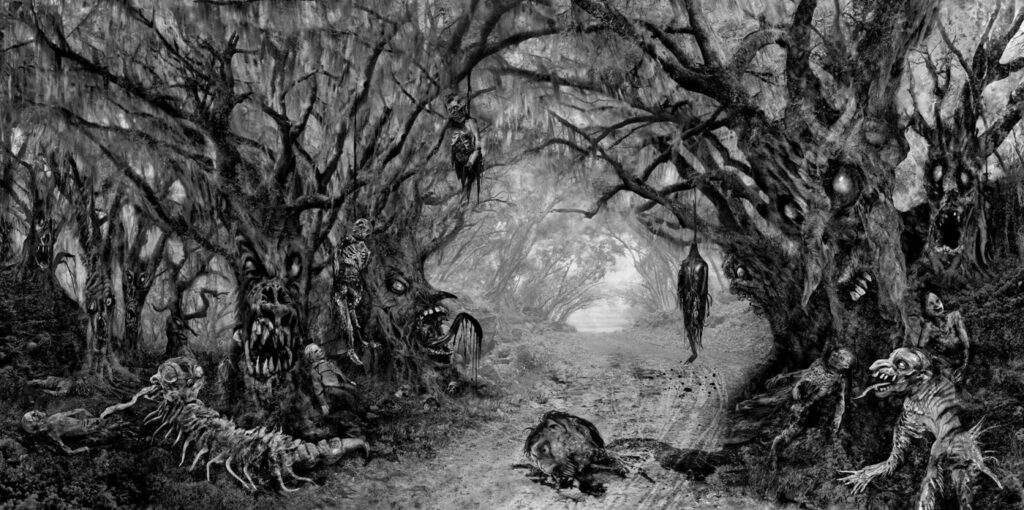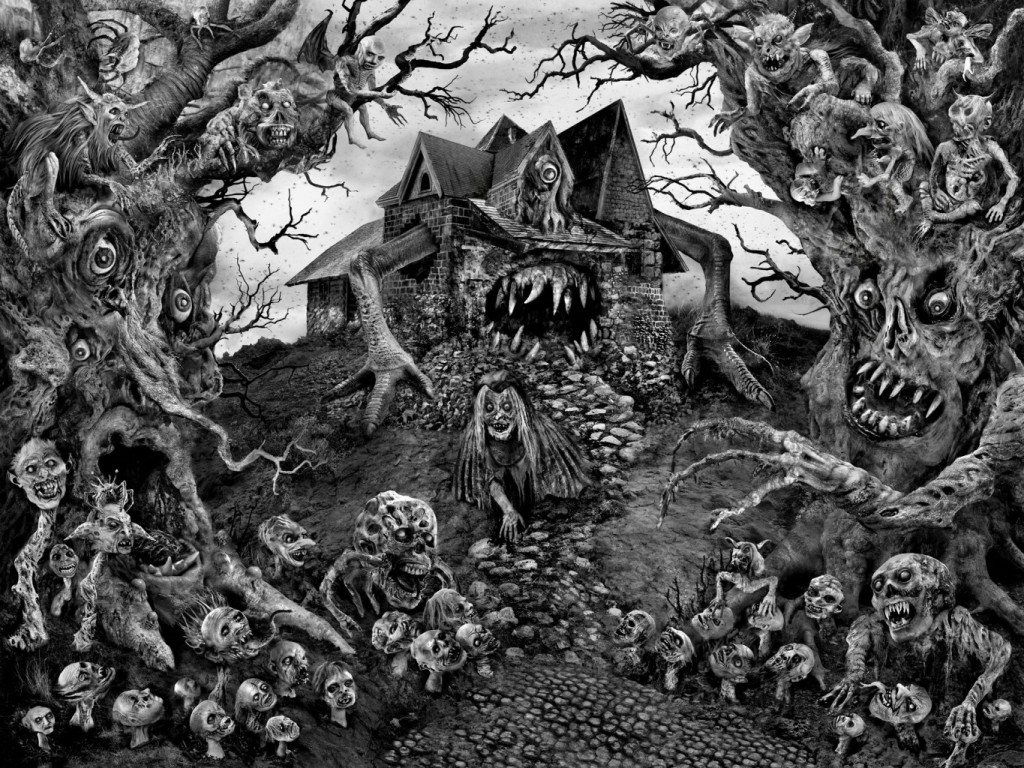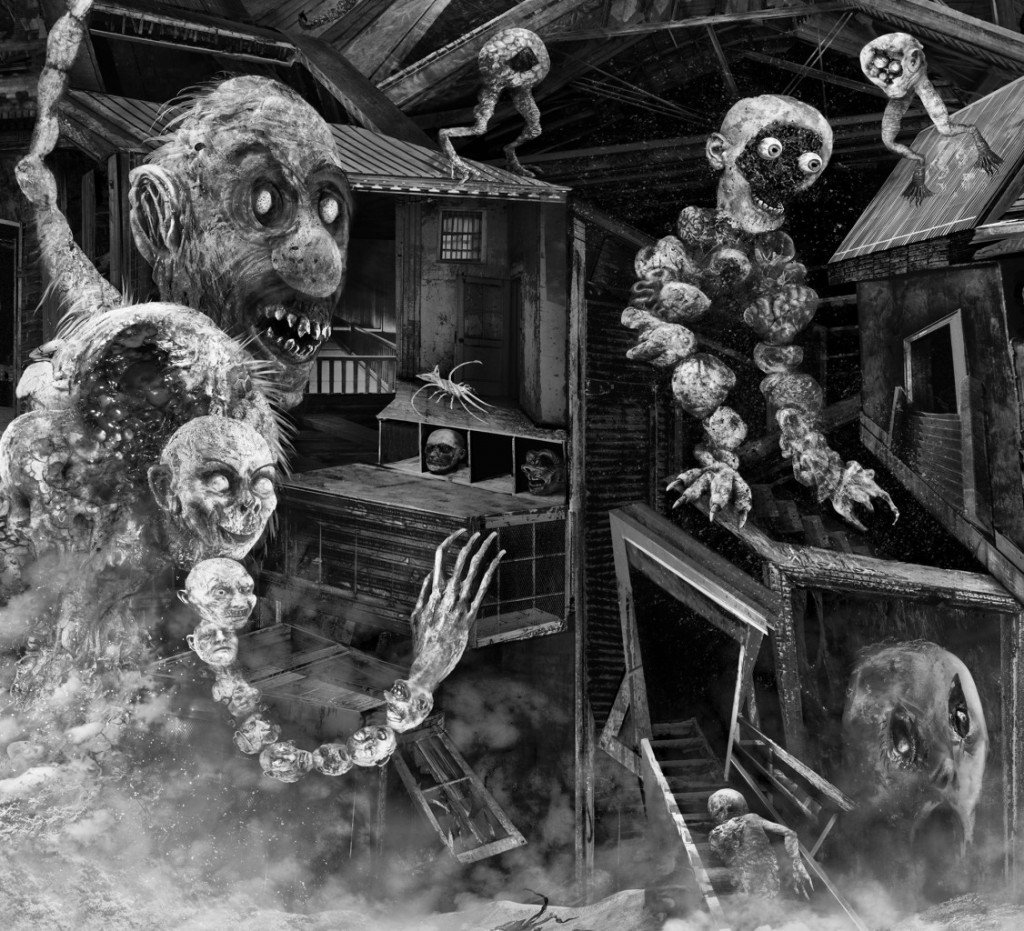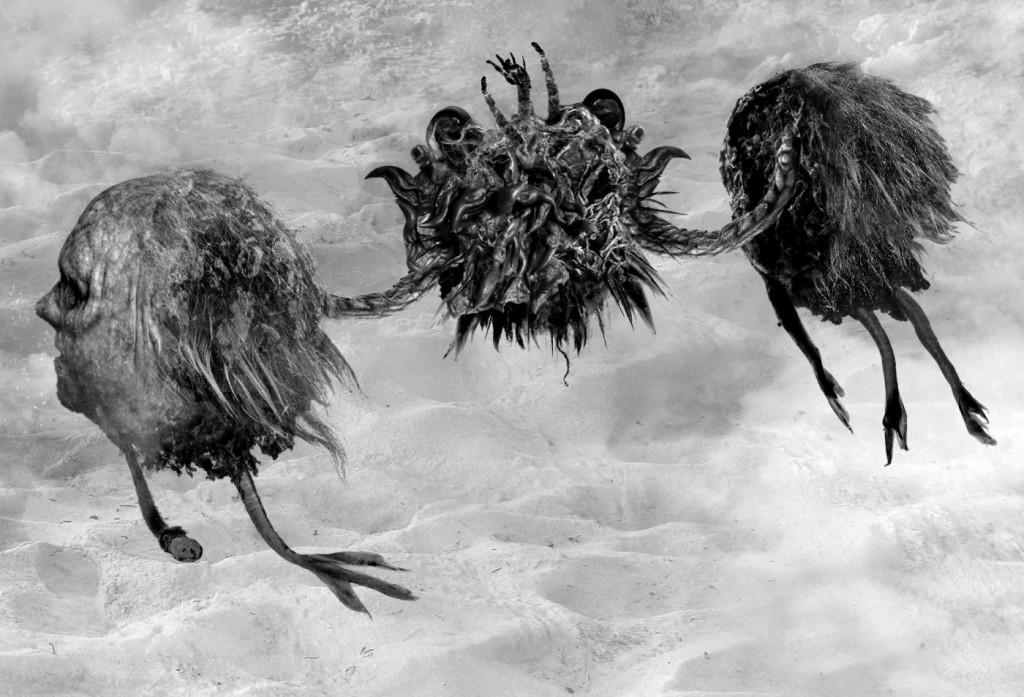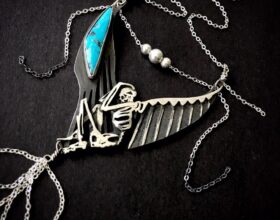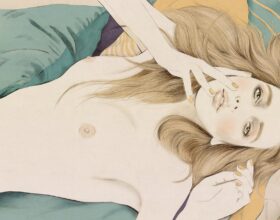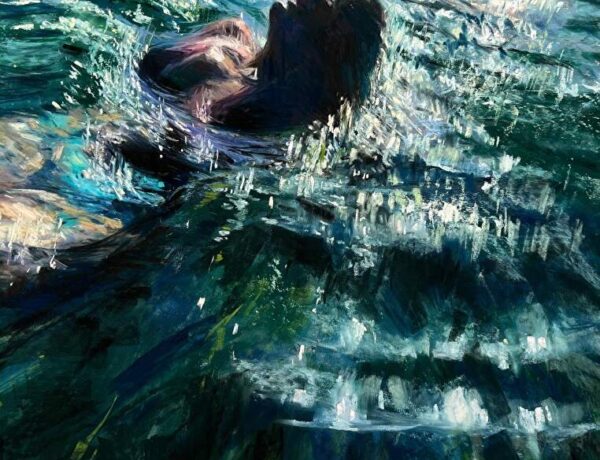There are nightmares so terrible, so deeply unsettling that our minds refuse them purchase. We retain only snapshots, fleeting glimpses of monstrosities too hideous for comprehension, and too alien for context in our ordinary lives. To do any more would permit not only the impossible, but also the spiritually abhorrent.
Aeron Alfrey, however, treads comfortably in these landscapes of the damned. He is a merchant of nightmares. Stylistically unique among his peers, Aeron’s digital paintings are both profoundly unnerving and meticulously crafted. They exist at the fever dream edge of our fears, where cosmic horror and oblivion render all hope an empty delusion. There is no escape, no safe haven, no waking in cold sweat. Fortunately, for those of us with a taste for this bleak strain of the macabre, Aeron was gracious enough to make time for an interview.
For readers who aren’t familiar with your work, would you provide an introduction? A bit about who you are and how you would characterize your own work? Are you self-taught, or do you have formal training as an artist?
I’m an artist obsessed with a deranged fantasy world that exists in my head to which I’ve given the name “The Land Of The Moth.” It is a place where I organize many of my creative ideas into a cohesive imaginary environment. The Moth is a place of nightmares, ruined abstract cities, fantastically grotesque characters, a dream world of death magic and monsters.
Regarding my training as an artist, I went to a traditional art school where I focused on drawing painting and traditional printmaking techniques. My skills related to digital imagery have all been a self-teaching experience, although my interests in digital techniques were inspired in an old-fashioned lithography studio. I recall watching someone experimenting with a composition for a stone lithographic print in Photoshop and discovering the potential of using layers for different areas of an artwork.
You seem to use color sparingly, is this a conscious decision or a natural inclination?
Much of the art is in black and white as it’s how the images would originally appear in my head. I’ve always been interested in the strange reality that black and white films have, the twisted shadows and buildings of German expressionist films, the ambience of old Twilight Zone or Outer Limits episodes that I’m sure have contributed to my focus on black and white imagery.
Would you describe your creative process? How much planning goes into a piece? Do they take form and emerge as you work, or do you have a clear idea of the result before you begin?
I frequently draw in sketchbooks and return to them for ideas on various projects that I work on. The planning stage is extensive and I will usually scan in a rough sketch of a composition, cut the drawing apart digitally, then move elements of the image around, experiment with contrasts, proportions, etc. Generally, I will construct a loose composition with the main structural elements, be it landscape, cityscape, interior of a room, etc, and elaborate with outlined shapes representing where I want things happening. The light and dark contrasts will then be blocked in and I fine-tune the details from there. Very often, the imagery will grow into something that I wasn’t expecting from the start.
As I was working on the dust jacket for Thomas Ligotti’s “Songs Of A Dead Dreamer” published by Subterranean Press in 2010, I was sketching out a variety of characters walking down the street of Vastarien, a city based on Ligotti’s story of the same name. A wagon structure grew into a large beast with wagon wheel legs and from that, one of its appendages became a skeletal ventriloquist dummy of sorts. When it comes to conceptualizing the artwork, it’s a matter of letting the imagery go where it wants to go and not holding anything back.
I recently created an incredibly detailed dust jacket for a new horror anthology “Madhouse” to be published this year by Dark Regions Press, which will include an additional 31 interior artworks by me. The book itself is relatively average in size but I became obsessed with the imagery of the dust jacket and toiled away at every little scenario playing out across all of the windows and open rooms of the abstracted mental hospital in the work. I’ve since had the artwork printed on a good quality sheet of fabric at 9 by 4 some feet and the attention to detail was well worth it. Looking into such a detailed scene is very much like staring into the portal of another, very disturbed and strange, world. The ultimate goal will be to make the artwork available for purchase as a beautiful tapestry piece that will fill up an entire wall, although I intend to make a sized down version available for people with less wall space. In the future, I intend to create my more detailed artworks on a much grander scale such as this.
Transitioning to content for a moment, the majority of your work is explicitly, even proudly macabre. Where does this interest stem from personally? What are your thoughts about the connection between art and horror in general? In a previous interview, I found this link, can you expand upon your interest in the monstrous from such an early age, and how it has evolved over the years?
I am fascinated and inspired by frightening, terrible and grotesque things and always have been. I grew up watching horror and monster movies and discovered many of my favorite artists in my father’s art book and magazine collection. He had many back issues of Heavy Metal magazine that introduced me to the likes of Giger, Moebius, Richard Corben and Philippe Druillet. My father has a great imagination and would tell brothers and me many strange stories. There was a large knot high up on a tree down the street from where I grew up that he claimed was a sleeping gorilla that would climb down once a year to eat someone. In the local park was a large red brick building under a steep hill by a stream that housed lawn equipment for the park, a place that frightened me as it looked like a normal red brick house but had no traditional door. My father claimed that a big octopus slept in it during the day and it came out at night to prey upon anyone still in the park after dark. I always imagined a giant blood thirsty octopus with bulging bloodshot monster eyes, climbing into the shallow stream in search of people to eat. The list of stories goes on and I intend to create an illustrated book of many of these tales at some point in the future. Anyway, my head was always full of strange ideas, whether originating from my own wild imagination or my father’s.
Over the years, my youthful admiration of monsters from dinosaurs to Ray Harryhausen beasts has evolved into a devotion that has provoked me to research a vast amount of art connected to monsters throughout art history. While a very time consuming project in itself, I’ve maintained a site where I’ve shared and will continue to share some of this research at monsterbrains.blogspot.com
Is there a specific philosophy or worldview underlying your work? What kind of emotional reaction would you like to elicit from your audience?
I try to let the work speak for itself and let the viewer interpret each piece as far as an emotional reaction, thrill/horror/awe… but not necessarily in that order.
I first became aware of your art through Thomas Ligotti, and was instantly taken with it. Your covers seem like a natural fit for his writing, evoking many of the same unbalanced, nightmarish themes. Could you discuss how that collaboration came about? Do you have any upcoming projects with other authors or musicians?
I originally contacted Tom many years before the publication of the ‘Subterranean’ editions, somewhere around 2004. I wanted to collaborate with no intention of a published release of the art and he suggested an artwork inspired by his story Teatro Grottesco. My interpretation was a detailed scene inside of a decaying theater with a performance by a grotesque and disturbed array of characters. The work was never finished however. I’ve included examples from the artwork to show your audience. I intend to, at some point in the future, find a way to finish this work.
Regarding the Subterranean Press books, a musician/artist named Jonathan Dennison whom I’ve collaborated with let me know that they were going to be publishing new editions of Ligotti’s books. I’d previously created art for Jonathan’s band Unholy, interestingly they had a music video directed by Al Columbia that utilized some of my art created for the album. Jonathan has a new label called Cadabra Records that has recently released an amazing spoken world vinyl edition of Lee Brown Coye, a particularly amazing artist of the vintage pulp Weird Tales variety, titled “Lee Brown Coye | Where Is Abby? & Other Tales | Read by Robert Coye LP”. So he let me know about Subterranean’s intent to release new books of Ligotti’s writings and I was, of course, inspired to pursue these covers. I got the job and spent a great deal of time making the covers. I’ve always felt a deep creative connection to his writings and intend to create more art inspired by his writings in the future. I created a small illustration for Jeff Vandermeer years ago to accompany one of Tom’s short stories, “The Red Tower.” I’m including a link to it not only because it’s a great introduction to the work of Ligotti, but it also completely exemplifies the vividly terrifyingly imaginative world that inspires me so much in Tom’s works.
On upcoming projects, I’m working on a lot of things…
I’m creating a series of charcoal drawings for the tabletop game “Cave Evil: War Cults” that will involve many battle scenes of monsters, demons, warlocks, skeletons, etc. I previously created artwork for the first edition of Cave Evil for Mat Brinkman that I think has since sold out. The following is a short film that summarizes the imagery from the game. As previously mentioned, I recently illustrated a new shared world horror anthology titled “Madhouse” with a multitude of talented authors involved that will be published this year from Dark Regions Press.
I’ve created numerous album covers and interior art for a variety of bands but I’ll leave it to them to announce and release the art in their own time. I’m working on other books but I’ll reserve any announcements regarding the art for the publishers. I’m also creating movie props (fake movie posters) to be used in a film featuring high profile horror actors, details of which I’ll reveal later this year. I have other long term in progress projects going on as well, I’m working on a fully illustrated game for Lamentations of the Flame Princess which I’ll be writing for as well. I’m developing a book of ‘witch inspired’ art that I’ve been wanting to do for years. And I have a few other books that are in early stages of development, some that would be entirely hand drawn comics.
Who are your influences as an artist?
Some favorite artists include Alfred Kubin, Cornelis Saftleven, Alberto Martini, Jacques Callot, Sibylle Rupert, Alessandro Magnasco, Marcel Roux, Dado (Miodrag Đurić), the stop motion works of Ladislas Starewitch, I’ve become obsessed with vintage Polish theatrical imagery over the last few years. I’ve been researching a lot of Expressionist architecture lately to get ideas on how to approach structural environments for a variety of projects.
How do you measure your own growth as an artist, and is there a goal in mind for that growth?
I learn new techniques regularly. It’s always nice when you stumble onto a way of doing something easier that you’ve struggled with over the years, it is in those moments that the growth is the most apparent. I’ve been thinking much more about lighting in my art and trying to use shadows and contrasts to as great an effect as possible. I”m interested in exploring 3D programs in the future, if only to use as a more easily altered understudy for a finished work. Experimenting with lighting effects inside a 3D sketch of a landscape sounds very appealing to me. The ideal goal for my creative growth would be to just work quicker so that I can make more art.<


